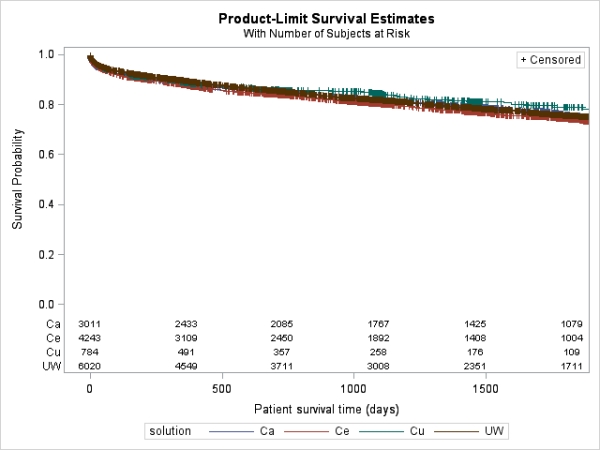The Effects of Various Cardiac Preservation Solutions on Survival After Heart Transplantation
Department of Surgery, Division of Cardiac Surgery, University of Maryland School of Medicine, Baltimore, MD.
Meeting: 2015 American Transplant Congress
Abstract number: C175
Keywords: Heart preservation, Heart transplant patients
Session Information
Session Name: Poster Session C: "Loss of Breath": VADs and Other Pre-Heart Transplant Matters
Session Type: Poster Session
Date: Monday, May 4, 2015
Session Time: 5:30pm-6:30pm
 Presentation Time: 5:30pm-6:30pm
Presentation Time: 5:30pm-6:30pm
Location: Exhibit Hall E
Purpose: The optimal cardiac preservation solution is still debated. The purpose of this study is to determine whether the type of cardiac preservation solution has an effect on patient outcomes after heart transplantation.
Methods: The United Network for Organ Sharing (UNOS) database was queried for recipients older than 18 years who underwent heart transplantation between 10/3/1987 and 12/31/2012. Heart-lung transplants were excluded. The preservation solutions compared were local institutional cardioplegia, Celsior, Custodial and University of Wisconsin (UW) solutions. The outcome measures were Kaplan-Meier survival estimates at 30 days, 1 year and 5 years, which were compared using the log-rank test.
Results: Of all the heart recipients 16,282 fit the inclusion criteria. There were no important differences among the groups at baseline (Table 1). The Kaplan-Meier survival estimates at 30 days were 94.9%, 95.1%, 95.9% and 95.9%; at 1 year were 88.1%, 87.8%, 88.8% and 89.4%; and at 5 years were 75.6%, 74.1%, 79.0% and 75.6% for patients who received hearts preserved with cardioplegia, Celsior, Custodial and UW solutions, respectively (p = 0.0727).
Conclusions: Current cardiac preservation solutions seem to have equivalent effects on short- and long-term outcomes after heart transplantation. Further analyses with respect to high-risk donors, prolonged ischemic time, and primary graft failure rates may help differentiate these solutions.
| All (n=16282) | Cardioplegia (n=3012) | Celsior (n=4257) | Custodial (n=784) | UW (n=6030) | |
| Median age (IQR), years | 54 (46-60) | 54 (45-61) | 55 (45-61) | 54 (44-61) | 55 (46-62) |
| Men | 75.4% | 75.1% | 75.7% | 76.4% | 75.4% |
| Status IA | 48.0% | 42.3% | 50.1% | 46.8% | 48.8% |
| Status IB | 38.3% | 39.8% | 37.5% | 45.5% | 37.0% |
| Status II | 13.6% | 17.7% | 12.3% | 7.7% | 14.3% |
| VAD | 17.6% | 16.8% | 15.3% | 24.7% | 18.1% |
| Median ischemic time (IQR) hours | 2.96 (2.24-3.64) | 3.19 (2.48-3.89) | 3.23 (2.51-3.83) | 3.09 (2.43-3.73) | 3.23 (2.48-2.91) |

To cite this abstract in AMA style:
Evans C, Rajagopal K, Sanchez P, Rahimpour S, Cheema F, III RPierson, Griffith B, Pham S. The Effects of Various Cardiac Preservation Solutions on Survival After Heart Transplantation [abstract]. Am J Transplant. 2015; 15 (suppl 3). https://atcmeetingabstracts.com/abstract/the-effects-of-various-cardiac-preservation-solutions-on-survival-after-heart-transplantation/. Accessed December 14, 2025.« Back to 2015 American Transplant Congress
